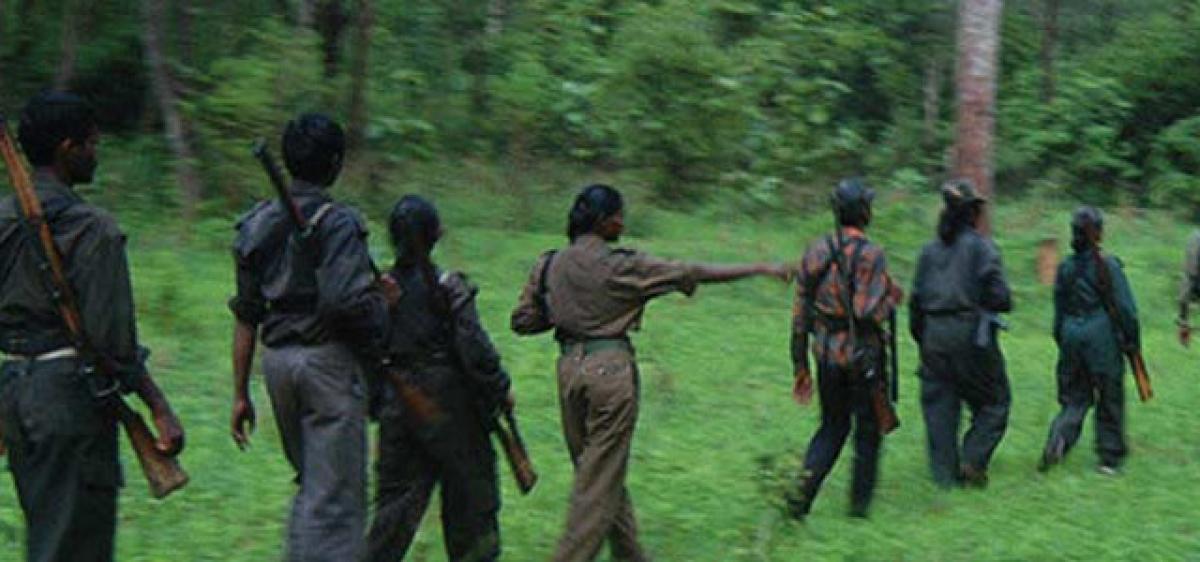Live
- BJP urges EC to stop Cong’s ‘Guarantee Cards’ campaign aimed to 'induce voters'
- Congress cheated Madigas: Dr. RS Praveen Kumar
- CBDT signs record 125 pacts to ease tax payments by big multinational firms
- Kamal Nath accuses BJP of ‘threatening’ Congress leaders in Chhindwara
- Odisha: BJP, BJD allege violation of MCC
- PM Modi lands in Guwahati to kickstart poll campaign
- ‘100 day action plan’ is PM Modi’s signature style for setting goals and meeting targets
- BJP will change the Constitution if they come to power again, says Priyanka Gandhi
- BJP-led NDA to cross 390-mark in Lok Sabha polls, predicts India TV-CNX survey
- Haier launches new TV series in four sizes in India
Just In

The cycle of violence that left scores of paramilitary personnel and Maoists killed raises concern. Despite a talk of a political solution to the Left extremist question, the government is pursuing a military option. The unrelenting bloodshed in the tribal hinterland has never mitigated the problem and infact led to the further worsening of the situation.
The cycle of violence that left scores of paramilitary personnel and Maoists killed raises concern. Despite a talk of a political solution to the Left extremist question, the government is pursuing a military option. The unrelenting bloodshed in the tribal hinterland has never mitigated the problem and infact led to the further worsening of the situation.
The Maoists should at least now realise that they cannot challenge mighty Indian State with their military fire power. They can at best inflict intermittent causalities but it is not without retaliation as evident from the recent events in central India.
Similarly, however mighty State it may be, the government should also realise that they cannot militarily defeat Maoists especially in such a geographical terrain most suitable to the guerrilla warfare, that too, when the tribal question still remains unaddressed.
None can agree with the ideology of individual annihilation propounded by the Maoists. Their armed tactics have no place in a democratic society. But, none can also dismiss the relevance of the Jal, Jungle and Jameen (water, forest and land) issues raised by the Maoist insurgency.
A Planning Commission expert group report, Development Challenges in Extremist Affected Areas, in 2008 also underlined this dimension. The government policy response fails to appreciate social and economic causes of such a challenge.
Maoists despite serious ideological aberrations continue to be a political movement. The violence thrown up by a political movement cannot be challenged only by use of force as State alone does not have a monopoly over the use of force.
The acute agrarian distress, the changing modes of production that make these skills possessed by them irrelevant, high levels of pilferage in welfare spending, displacement in the name of development etc., have further buttressed the sense of discontent and alienation among such oppressed sections, especially in interior forest and tribal-dominated areas and habitations.
The Left extremist influence is more pronounced in tribal areas. There are notable causative factors for this. The Planning Commission report has rightly observed that the contradiction between the tribal community and the State itself has become sharper, translating into an open conflict in many areas.
Socio-economic infrastructure among the tribal people is woefully inadequate, thereby contributing to their disempowerment and deprivation. The causes of the tribal unrest include absence of self-governance, hostile forest and excise policy, land-related issues, multifaceted forms of exploitation, cultural humiliation and political marginalisation.
Land alienation, forced evictions from land and displacement also added to unrest. Failure to implement protective regulations in Scheduled Areas, absence of credit mechanism leading to dependence on money lenders, consequent loss of land and often even violence by the State functionaries add to the problem.
Tribals are evicted from their traditional homes and habitations in the name of conservation and development without providing them a hospitable environment and alternative livelihoods to lead a better life.
Thus, tribals are deprived of unhindered access to land, water and forests which they enjoyed for centuries. Precisely, this is providing a breeding ground for spread of Maoist activities. Failure to recognise this would only end up in recurring violence.

© 2024 Hyderabad Media House Limited/The Hans India. All rights reserved. Powered by hocalwire.com







